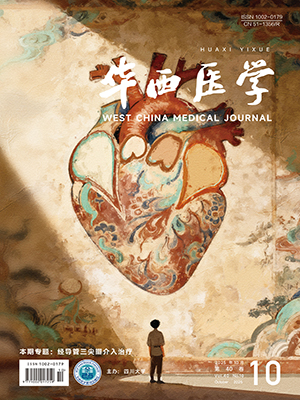| 1. |
Planes AM, Calleja R, Bernet A, et al. Evaluation of the usefulness of aquantitative blood culture in the diagnosis of catheter-related blood stream infection: comparative analysis of two periods (2002 and 2012). Enferm Infect Microbiol Clin, 2016, 34(8): 484-489.
|
| 2. |
Buetti N, Ruckly S, Lucet JC, et al. Practice and intravascular catheter infection during on- and off- hours incritically ill patients. Ann Intensive Care, 2021, 11(1): 153.
|
| 3. |
汤艳春, 姚春梅. 神经外科重症监护病房患者发生血管内导管相关血流感染的危险因素分析. 护理实践与研究, 2021, 18(13): 1920-1923.
|
| 4. |
袁美娇, 王春艳, 蔡学联. 我国中心静脉导管相关性血流感染研究的文献计量学分析. 护士进修杂志, 2019, 34(7): 602-605, 667.
|
| 5. |
Nakamura I, Fukushima S, Hayakawa T, at el. The additional costs of catheter-related bloodstream infections in intensive care units. Am J Infect Control, 2015, 43(10): 1046-1049.
|
| 6. |
Liu H, Liu H, Deng J, et al. Preventing catheter-related bacteremia with taurolidine-citrate catheter locks: a systematic review and meta-analysis. Blood Purif, 2014, 37(3): 179-187.
|
| 7. |
国家卫生健康委办公厅医政医管局. 血管导管相关感染预防与控制指南(2021 版). 中国感染控制杂志, 2021, 20(4): 387-388.
|
| 8. |
O’Grade NP, Alexander M, Burns LA, et al. Summary of recommendations: guidelines for the prevention of intravascular catheter-related infections. Clin Infect Dis, 2011, 52(9): 1087-1099.
|
| 9. |
中华人民共和国国家卫生和计划生育委员会. 重症监护病房医院感染预防与控制规范: WS/T509-2016. 北京: 中国标准出版社, 2017.
|
| 10. |
中华人民共和国国家卫生和计划生育委员会. 临床微生物实验室血培养操作规范: WS/T 503-2017. 北京: 中国标准出版社, 2017.
|
| 11. |
Vanshi PG, Virginkar N, Popiel B, et al. Incidence of and factors associated with catheter related bloodstream infection in patients with advanced solid tumors on home parenteral nutrition managed using a standardized catheter care protocol. BMC Infect Dis, 2017, 17(1): 372.
|
| 12. |
Tao FZ, Jiang R, Chen Y, et al. Risk factors for early onset of catheter-related bloodstream infection in an intensive care unit in China: a retrospective study. Med Sci Monit, 2015, 21: 550-556.
|
| 13. |
Miliaraki M, Katzilakis N, Chranioti I, et al. Central line-associated bloodstream infection in childhood malignancy: single-center experience. Pediatr Int, 2017, 59(7): 769-775.
|
| 14. |
Umscheid CA, Mitchell MD, Doshi JA, et al. Estimating the proportion of healthcare-associated infections that are reasonably preventable and the related mortality and costs. Infect Control Hosp Epidemiol, 2011, 32(2): 101-114.
|
| 15. |
Gao Y, Liu Y, Ma X, et al. The incidence and risk factors of peripherally inserted central catheter-related infection among cancer patients. Ther Clin Risk Manag, 2015, 11: 863-871.
|
| 16. |
张俏, 贾冰, 张晓慧, 等. 综合干预措施在提高住院患者抗菌药物治疗前病原学送检率中的效果评价. 中国实验诊断学, 2025, 29(1): 61-66.
|
| 17. |
曹煜隆, 单娇, 龚志忠, 等. 中央导管相关血流感染管理成效序贯分析. 中国感染控制杂志, 2021, 20(9): 822-826.
|
| 18. |
Tan CC, Zanariah Y, Lim KI, et al. Central venous catheter-related blood stream infections: incidence and analysis of risk factors. Med J Malaysia, 2007, 62(5): 370-374.
|
| 19. |
Laupland KB, Koulenti D, Schwebel C. The CVC and CRBSI: don’t use it and lose it!. Intensive Care Med, 2018, 44(2): 238-240.
|
| 20. |
van der Kooi T, Sax H, Pittet D, et al. Prevention of hospital infections by intervention and training (PROHIBIT): results of a pan-European cluster randomized multicentre study to reduce central venous catheter-related bloodstream infections. Intensive Care Med, 2018, 44(1): 48-60.van der Kooi T, Sax H, Pittet D, et al. Prevention of hospital infections by intervention and training (PROHIBIT): results of a pan-European cluster randomized multicentre study to reduce central venous catheter-related bloodstream infections. Intensive Care Med, 2018, 44(1): 48-60.
|
| 21. |
曾翠, 李六亿, 贾会学, 等. 重症监护病房中央导管相关血流感染的干预研究. 中国感染控制杂志, 2015, 14(8): 535-539.
|
| 22. |
杜学娜, 张岩, 董爱英, 等. 中心静脉导管留置部位及时间与感染发生的相关性分析. 中国临床医生杂志, 2017, 45(1): 47-49.
|
| 23. |
Hu KK, Veenstra DL, Lipsky PA, et al. Use of maximal sterile barriers during central venous catheter insertion: clinical and economic outcomes. Clin Infect Dis, 2004, 39(10): 1441-1445.
|
| 24. |
张静, 高晓东, 胡必杰, 等. 重症监护病房医护人员导管相关性血流感染现状与预防控制措施认知的调查. 中华医院感染学杂志, 2011, 21(12): 2411-2413.
|
| 25. |
李芸芸, 余雪梅, 刘明秀. 外周静脉置管导管相关性感染护理措施预防效果的系统评价. 中华现代护理杂志, 2016, 22(20): 2869-2872.
|
| 26. |
李静, 胡爱香, 张越巍, 等. 重点科室护士医院感染防控知识水平调查. 中华现代护理杂志, 2019, 25(3): 357-359.
|




